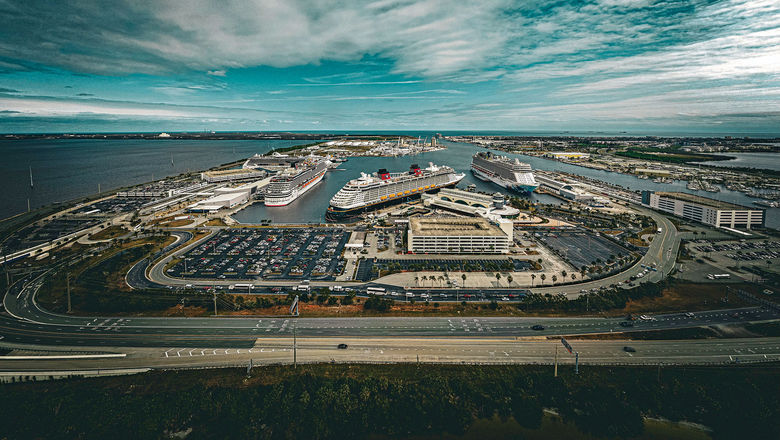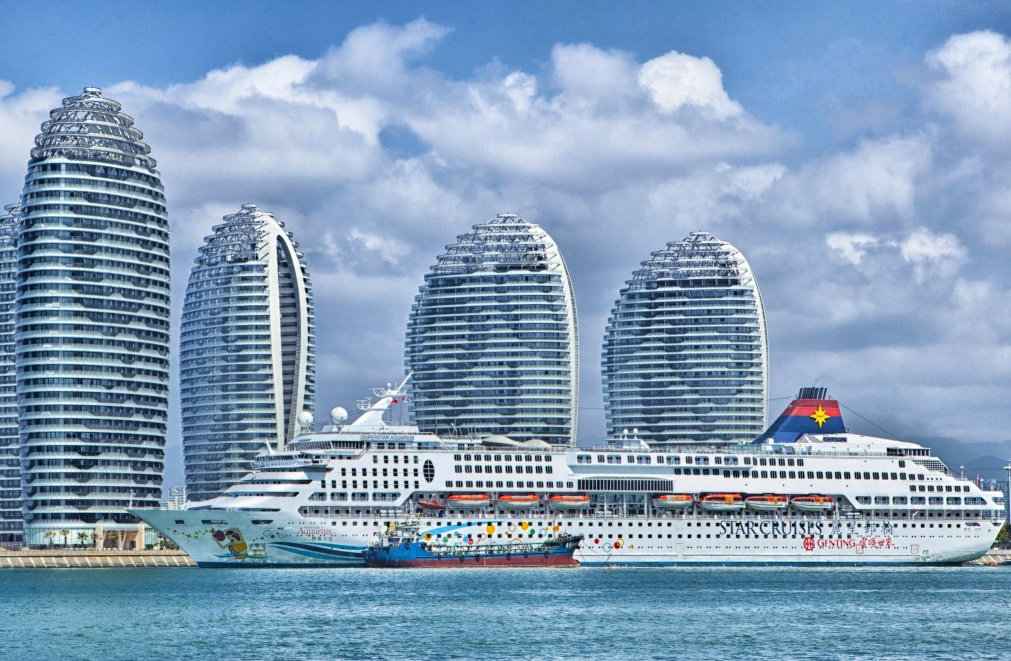The busiest cruise port in the world is the Port of Miami, known as the “Cruise Capital of the World.” It consistently sees the largest volume of passengers annually.
With crystal-clear waters and sunny skies, Miami serves as the pinnacle of cruise vacations, drawing countless tourists every year. The port hosts an array of the world’s most renowned cruise lines, offering journeys to exotic destinations. Its strategic location acts as a gateway to the Caribbean, amplifying its attraction among cruise enthusiasts.
Evolving continuously, Miami’s port facilities cater to the needs of millions, combining modern amenities with efficient services to ensure a seamless start and end to any maritime adventure. As a bustling hub of travel, the Port of Miami underscores the city’s standing as a premier destination for global cruise travelers.
Quick Navigation
Global Cruise Industry: A Snapshot
Welcome aboard as we navigate through the global cruise industry, providing you with a snapshot of a sector that’s been both a significant economic contributor and a beacon of leisure and luxury for travelers around the world. Dynamic and opulent, the industry encapsulates a spirit of adventure that calls to millions yearly.

Economic Impact
The global cruise industry steers a massive economic ship, contributing billions to economies worldwide.
Here’s a view of its economic prowess:
- Job creation across multiple sectors
- A rise in local and international tourism
- Increase in port-related developments
Ports bustling with travelers fuel local businesses and infrastructure, echoing the industry’s deep-seated reach into economies.
Rise In Cruise Tourism
Cruise tourism is riding a wave of popularity with exceptional experiences and exotic destinations. Let’s chart its growth:
- More ship launches with cutting-edge amenities
- Diverse destinations attracting global passengers
- Affordable packages making cruising accessible
The industry’s surge has turned ports into vibrant hubs where the journey’s joy begins.

Decoding The Busiest Cruise Ports
Welcome to the captivating world of cruise travel, where the hustle and bustle isn’t just on the high seas. It’s also in the ports bustling with enthusiastic travelers eager to embark on their next adventure. In this deep dive, we unravel which ports see the most action. Port rankings can tell us a lot about travel trends and the cruise industry’s hottest destinations.
Key Criteria For Ranking
Determining the busiest cruise port involves several factors:
- Passenger Traffic: The number of passengers passing through the port.
- Ship Arrivals: How many ships dock there.
- Capacity: A port’s ability to handle large cruise liners.
- Destination Popularity: The appeal adds to its traffic.
Table to represent data if available <!– additional rows as needed
| Rank | Port | Passenger Count | Ship Arrivals |
|---|---|---|---|
| 1 | Miami | XXX,XXX | XXX |
Comparison With Other Ports
Let’s size up our busiest port against others across the globe:
- Passenger Volume: Does it handle more travelers?
- Facilities: Are they more advanced and accommodating?
- Location: Is it closer to major attractions?
- Services: Do they offer top-notch experiences?
Ports in Florida, such as Miami and Port Canaveral, often top the list. They serve as gateways to the Caribbean, the world’s most frequented cruise destination. Asia and Europe’s leading ports, like Barcelona and Shanghai, also compete fiercely, drawing millions with their rich cultures and stunning landmarks.
The Reigning Champion: Port Of Miami
The Port of Miami stands as a titan among cruise ports worldwide.
Known affectionately as the “Cruise Capital of the World,” the Port of Miami wears its crown with bustling pride. Its position ensures it remains a beacon of maritime activity.
Annual Passenger Numbers
Each year, millions of passengers embark on their sea voyages from this port. The numbers prove its dominance in the cruise industry. Impressive figures highlight the port’s capacity to welcome a staggering flux of guests, ready to sail the Caribbean blues.
- Exciting cruise options draw vast crowds.
- It continually sets new records for passenger traffic.
- Diverse cruise lines and itineraries contribute to its ever-growing popularity.
Infrastructure And Facilities
The Port of Miami is equipped to handle the massive influx of vacationers. Its advanced infrastructure and modern facilities ensure passenger comfort and efficiency in embarkation.
| Feature | Description |
|---|---|
| Terminals | State-of-the-art and equipped to cater to the largest cruise vessels. |
| Transport links | Easy access via road, rail, or air. |
| Services | A wide array of amenities including dining, shopping, and lounging areas. |
Its unmatched sophistication in handling both ships and passengers sets the Port of Miami apart as a true champion.

Factors Behind Miami’s Dominance
The title of busiest cruise port in the world belongs to Miami. This status is not a mere coincidence but the result of several key factors that work in favor. A closer look into these elements reveals why Miami continues to lead in the cruise industry.
Strategic Location
Miami’s geographical position plays a pivotal role. Situated at the crossroads of the Caribbean and the Americas, Miami serves as a convenient starting point. This strategic location ensures easy access to a variety of cruise destinations.
Cruises from Miami offer a plethora of enticing options for travelers. With short routes to the Caribbean and proximity to the Bahamas, the city is perfectly placed. Additionally, Miami’s location also opens up routes to Central and South America.
Partnerships And Collaborations
A network of partnerships bolsters Miami’s port dominance. Collaborations between cruise lines and the city help in customizing cruise experiences. These alliances ensure seamless operations and heighten tourist satisfaction.
- Joint ventures have led to exclusive terminals and facilities geared towards specific cruise lines.
- Partnerships extend to the local economy, thriving on tourism.
- Strategic collaborations foster innovation in cruise offerings, thus attracting more travelers.
This network not only enhances the port’s efficiency but also promotes Miami as a premium cruise hub globally.
Economic Ripple Effect
The busiest cruise port in the world acts as a massive engine powering the economy. This engine starts when ships dock and continues far beyond the harbor. This economic ripple effect touches various sectors, creating jobs, and boosting local tourism. The cycle of benefits shows the true impact of being a bustling cruise hub.
Local Job Creation
Jobs bloom where cruise ships call home. Employment opportunities arise in many areas:
- Port operations
- Ship maintenance
- Local transport providers
- Hospitality services
Thousands of people find work, from port staff to tour guides. These jobs often pay well and teach valuable skills.
Boost To Regional Tourism
Cruise passengers explore beyond the port. They visit landmarks, dine at local eateries, and shop at nearby stores. This passenger flow revitalizes regional tourism, which leads to:
| Benefit | Impact |
|---|---|
| Increased foot traffic | Higher sales for businesses |
| Wider recognition | Destination marketing boost |
| Infrastructure investments | Better facilities and services |
In short, the busiest cruise port seeds growth that spreads far and wide, enriching the area’s economy.
The Future Of Cruise Ports
As the cruise industry continues to expand, the future of cruise ports becomes a thrilling prospect. Not only do we witness evolving global hotspots, but sustainability emerges as a key player in port development. This outlook points towards transformative changes for both cruise line giants and passengers alike.
Emerging Competitors
New destinations are making waves in the cruise world. Glassy harbors and modern facilities rise to meet growing demands. These ports aim to dethrone the busiest hubs. They offer unique experiences and easier access to untouched locales.
Let’s explore who’s climbing the cruise ladder:
- Asia: Rapidly growing markets with state-of-the-art ports.
- Middle East: Luxurious amenities attracting cruise lines.
- Latin America: Diverse ports offering rich cultural encounters.
Sustainable Port Development
Eco-friendly design takes center stage as cruise ports adapt to green trends. Sustainability drives innovation, leading to ports that benefit their communities and the environment.
The upcoming features in port development include:
- Green Technology: Usage of solar and wind energy in operations.
- Waste Management: Systems that reduce environmental impact.
- Shore-side Power: Allows ships to turn off engines and reduce emissions.
These bold moves aim to secure a healthier planet while enhancing guest experiences.
Frequently Asked Questions
Which Port Is The World’s Busiest Cruise Port?
Miami is globally recognized as the busiest cruise port. Each year, it serves millions of passengers, hosting numerous cruise lines.
What Makes A Cruise Port Busy?
Passenger volume and ship traffic determine a port’s busyness. Facilities, location, and tourist attractions also increase cruise port activity.
How Many Passengers Transit Through The Busiest Port Annually?
The busiest cruise port, Miami, handles over 5 million passengers annually. The exact number varies from year to year.
Are There Benefits To Cruising From The Busiest Port?
Yes, the busiest port offers numerous cruise options and itineraries, state-of-the-art facilities, and easy access to a variety of destinations.
Conclusion
Navigating the waves of bustling maritime hubs leads us to one the Port of Miami reigns supreme. With its impressive passenger count and diverse cruise offerings, this port’s title as the busiest is well-deserved.
So, as you set sail on your next voyage, consider starting from the heart of cruise activity – where adventure and efficiency meet.
